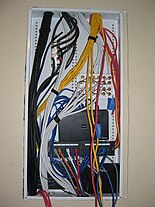Related Research Articles

X10 is a protocol for communication among electronic devices used for home automation (domotics). It primarily uses power line wiring for signaling and control, where the signals involve brief radio frequency bursts representing digital information. A wireless radio-based protocol transport is also defined.
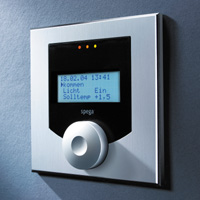
Home automation or domotics is building automation for a home. A home automation system will monitor and/or control home attributes such as lighting, climate, entertainment systems, and appliances. It may also include home security such as access control and alarm systems.
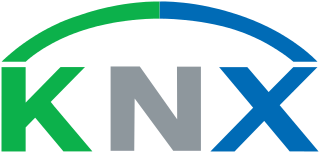
KNX is an open standard for commercial and residential building automation. KNX devices can manage lighting, blinds and shutters, HVAC, security systems, energy management, audio video, white goods, displays, remote control, etc. KNX evolved from three earlier standards; the European Home Systems Protocol (EHS), BatiBUS, and the European Installation Bus.
Zigbee is an IEEE 802.15.4-based specification for a suite of high-level communication protocols used to create personal area networks with small, low-power digital radios, such as for home automation, medical device data collection, and other low-power low-bandwidth needs, designed for small scale projects which need wireless connection. Hence, Zigbee is a low-power, low data rate, and close proximity wireless ad hoc network.
Nordic Semiconductor ASA is a Norwegian fabless technology company specializing in designing ultra-low-power wireless communication semiconductors and supporting software for engineers developing and manufacturing IoT products.
The EnOcean technology is an energy harvesting wireless technology used primarily in building automation systems, but also in other application fields such as industry, transportation, logistics or smart homes solutions. The energy harvesting wireless modules are manufactured and marketed by the company EnOcean, headquartered in Oberhaching near Munich. The modules combine micro energy converters with ultra low power electronics and wireless communications and enable batteryless, wireless sensors, switches, and controls.
Building automation(BAS), also known as building management system (BMS) or building energy management system (BEMS), is the automatic centralized control of a building's HVAC (heating, ventilation and air conditioning), electrical, lighting, shading, access control, security systems, and other interrelated systems. Some objectives of building automation are improved occupant comfort, efficient operation of building systems, reduction in energy consumption, reduced operating and maintaining costs and increased security.
Universal Powerline Bus (UPB) is a proprietary software protocol developed by Powerline Control Systems for power-line communication between devices used for home automation. Household electrical wiring is used to send digital data between UPB devices via pulse-position modulation.

Daintree Networks, Inc. was a building automation company that provided wireless control systems for commercial and industrial buildings. Founded in 2003, Daintree was headquartered in Los Altos, California, with an R&D lab in Melbourne, Australia.
Ember was an American company based in Boston, Massachusetts, USA, which is now owned by Silicon Labs. Ember had a radio development centre in Cambridge, England, and distributors worldwide. It developed Zigbee wireless networking technology that enabled companies involved in energy technologies to help make buildings and homes smarter, consume less energy, and operate more efficiently. The low-power wireless technology can be embedded into a wide variety of devices to be part of a self-organizing mesh network. All Ember products conform to IEEE 802.15.4-2003 standards.

Digi XBee is the brand name of a popular family of form factor compatible wireless connectivity modules from Digi International. The first XBee modules were introduced under the MaxStream brand in 2005 and were based on the IEEE 802.15.4-2003 standard designed for point-to-point and star communications. Since the initial introduction, the XBee family has grown and a complete ecosystem of wireless modules, gateways, adapters and software has evolved.

An RF module is a (usually) small electronic device used to transmit and/or receive radio signals between two devices. In an embedded system it is often desirable to communicate with another device wirelessly. This wireless communication may be accomplished through optical communication or through radio-frequency (RF) communication. For many applications, the medium of choice is RF since it does not require line of sight. RF communications incorporate a transmitter and a receiver. They are of various types and ranges. Some can transmit up to 500 feet. RF modules are typically fabricated using RF CMOS technology.
IQRF is a technology for wireless packet-oriented communication via radio frequency (RF) in sub-GHz ISM bands. It is intended for general use where wireless connectivity is needed, either point-to-point or in complex networks, e.g. for telemetry, industrial control, automation of buildings and cities and Internet of Things. Fully open functionality depends solely on a user-specific application.
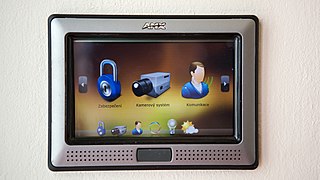
This is a list of home automation topics on Wikipedia. Home automation is the residential extension of building automation. It is automation of the home, housework or household activity. Home automation may include centralized control of lighting, HVAC, appliances, security locks of gates and doors and other systems, to provide improved convenience, comfort, energy efficiency and security.
Universal Electronics Inc. (UEI) is an American smart home technology provider and manufacturer of universal remote controls, IoT devices such as voice-enabled smart home hubs, smart thermostats, home sensors; as well as a white label digital assistant platform optimized for smart home applications, and other software and cloud services for device discovery, fingerprinting and interoperability. The company designs, develops, manufactures and ships products both under the "One For All" brand and as an OEM for other companies in the audio video, subscription broadcasting, connected home, tablet and smart phone markets. In 2015, it expanded its product and technology platform to include home automation, intelligent sensing and security.
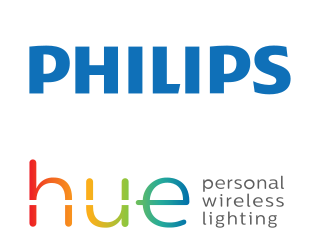
Philips Hue is a line of color-changing LED lamps and white bulbs which can be controlled wirelessly. The Philips Hue line of bulbs was the first smart bulb of its kind on the market. The lamps are currently created and manufactured by Signify N.V., formerly the Philips Lighting division of Royal Philips N.V.
Matter is an open-source connectivity standard for smart home and Internet of things devices, which aims to improve their compatibility and security.

Home Assistant is free and open-source software for home automation designed to be a central control system for smart home devices with a focus on local control and privacy. It can be accessed through a web-based user interface by using companion apps for Android and iOS, or by voice commands via a supported virtual assistant such as Google Assistant or Amazon Alexa.
Homey is a smart home hub manufactured by the Dutch company Athom B.V..
References
- ↑ The best smart home hubs of 2021 | Tom's Guide
- ↑ "Home Automation Made Easy: Combine Home Assistant, ESPHome and MySensors". 16 September 2020.
- ↑ "What Is a Smart Home Hub and Do You Need One?" . Retrieved 2021-08-04.
- ↑ "Logitech Harmony Hub Review" . Retrieved 2021-08-04.
- ↑ "Tek.no - Tester, guider, teknologi" (in Norwegian). 15 February 2020. Retrieved 2021-08-04.
- ↑ Steinung, Av Truls (2021-05-05). "Test: Google Nest Hub" (in Norwegian). Retrieved 2021-08-04.
- ↑ Nordby, Geir Gråbein (17 March 2021). "En ny og bedre Google Nest Hub" (in Norwegian Bokmål). Retrieved 2021-08-04.
- ↑ "Amazon unveils new Echo Show, Dot, and much more". Android Authority. 20 September 2018. Retrieved 20 September 2018.
- ↑ Delaney, John R.; Colon, Alex; Moscaritolo, Angela (2021-02-10). "What Is a Smart Home Hub (And Do You Need One)?". PCMag UK. Retrieved 2021-08-04.
